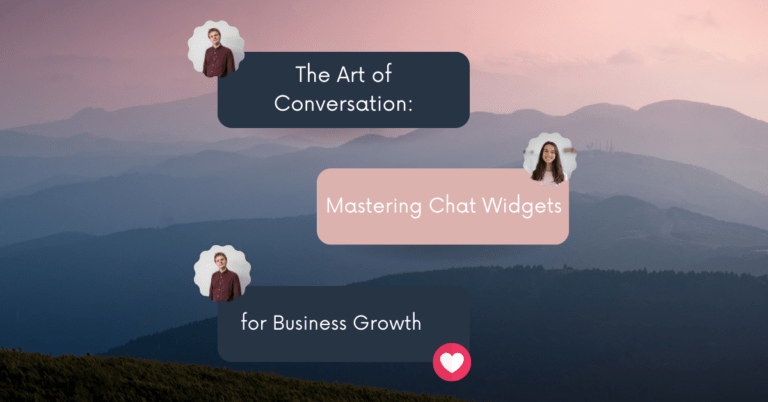Introduction:
In today’s digital age, customer service has become a crucial aspect for businesses to excel and retain their customers. With the rise of online shopping and remote interactions, providing exceptional customer support has become more challenging yet more critical than ever. One significant tool that has revolutionized customer service is the chat widget.
The chat widget is a user-friendly interface that allows customers to communicate with businesses in real-time. It offers quick and personalized support, eliminating the need for customers to wait for emails or phone calls. In this blog post, we will explore the increasing significance of chat widgets and delve into the future prospects of this technology in enhancing customer service experiences.
The Rise of Chat Widgets: Transforming Customer Service
In the past, customer communication channels were limited to phone calls, emails, and in-person visits. However, as technology advanced, businesses sought new ways to provide better customer experiences, leading to the emergence of chat widgets. These interactive tools have revolutionized customer service by allowing businesses to engage with their customers in real-time.
Chat widgets offer several advantages over traditional customer service channels. Firstly, they provide immediate assistance, eliminating the need for customers to wait for responses. Research has shown that customers prefer real-time support, and chat widgets fulfill that need effectively. They enable businesses to address customer queries promptly, leading to higher satisfaction levels and increased conversion rates.
Moreover, chat widgets allow for personalized support. With the ability to collect customer data and integrate with CRM systems, businesses can offer tailored assistance based on individual customer preferences and purchase history. Customers appreciate this personalized approach, as it makes them feel valued and understood.
Current State of Chat Widgets: Assessing Key Features and Functionality
The current chat widgets on the market have advanced features and functionalities that enhance the customer service experience. They are no longer limited to simple text-based chats but can include multimedia support, such as image or file sharing, and even integration with AI-powered chatbots.
Integration with AI and chatbots has significantly automated customer interactions. AI-powered chatbots can handle frequently asked questions, provide immediate responses, and even assist with simple problem-solving. This not only reduces customer waiting time but also allows human customer service agents to focus on more complex issues, ensuring efficient use of resources.
Another key feature of chat widgets is their omnichannel support. Customers can reach out to businesses using chat widgets through various channels, including websites, mobile apps, and social media platforms. This seamless integration ensures a consistent customer experience regardless of the platform they choose to communicate on.
Furthermore, chat widgets offer customization options to align with businesses’ branding and user preferences. They can be designed to match the website’s aesthetics, creating a seamless and integrated experience for customers. This branding synchronization helps reinforce the business’s identity and provides a cohesive visual experience throughout the customer journey.
The Future of Chat Widgets: What’s in Store?
The future of chat widgets holds immense potential for further improving customer service experiences. Here are a few developments that we can anticipate:
Predictive Analytics and Proactive Support: Chat widgets can leverage data analytics to anticipate customer needs. By analyzing customer behavior, past interactions, and purchase history, businesses can offer proactive support and suggest relevant products or services to customers even before they explicitly request assistance. This predictive approach enhances the overall customer experience and increases the likelihood of conversions.
Voice and Video Integration: While text-based chat widgets have been prevalent so far, the integration of voice and video communication within chat widgets can be the next big step. This would allow for more personal and interactive conversations, enabling customers to connect with businesses in a more human-like manner. Voice and video integration would also be valuable for addressing complex issues that require visual demonstration or explanation.
Integration on Social Media Platforms: Social media platforms have become significant touchpoints for businesses to interact with their customers. Chat widgets can be integrated into popular social media platforms, such as Facebook Messenger or WhatsApp Business, allowing businesses to provide customer support within the customer’s preferred communication channel. This integration streamlines the customer service process and ensures a consistent experience regardless of the platform used.
Virtual Reality and Augmented Reality Experiences: As technology advances, chat widgets can explore integrating virtual reality (VR) and augmented reality (AR) experiences. This could include providing virtual product demonstrations or allowing customers to visualize how a product would look in their physical environment. These immersive experiences would result in enhanced customer engagement and a deeper connection between the customer and the brand.
Challenges and Considerations for Implementing Chat Widgets in Customer Service
While chat widgets offer numerous benefits and a promising future, businesses need to be aware of certain challenges when integrating them into their customer service strategies:
Data privacy and security: Collecting and storing customer data through chat widgets raises concerns about data privacy. Businesses must ensure that robust security measures are in place to protect customer information and comply with data protection regulations.
Integration with existing systems: Integrating chat widgets with existing customer service systems can be challenging, especially if businesses are using multiple platforms or service providers. Ensuring seamless integration and effective data flow between systems is key to delivering a consistent and efficient customer service experience.
Training and upskilling: Customer service agents need to be trained on how to effectively utilize chat widgets and AI-powered chatbots. They should have the skills required to engage with customers in real-time, provide relevant answers, and handle complex situations. Continuous training and upskilling will be crucial to maximize the benefits of chat widgets.
Transition between channels: Customers often switch between different communication channels during their journey, such as moving from a chat widget conversation to a phone call. Businesses need to ensure a seamless transition between different channels to maintain continuity and avoid any disruption in the customer service experience.
Conclusion
Chat widgets have revolutionized customer service by providing real-time, personalized support. They offer several advantages over traditional customer service channels and have the potential to redefine the customer experience in the future. As technologies continue to advance, chat widgets can harness predictive analytics, voice and video integration, and even virtual reality to further enhance customer service interactions. However, businesses must be mindful of challenges such as data security, integration complexities, and the need for agent training. By embracing the evolving capabilities of chat widgets, businesses can stay ahead of the competition and deliver exceptional customer service experiences.
Thank you for reading! Share your experiences and questions in the comments below!




